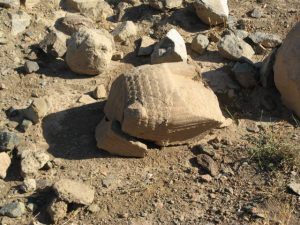
First discoveries

Topographic map of Gerçin Höyük (Robert Koldewey; Wartke 2005: 25).
In the late nineteenth century during the German excavations at the iron age settlement of Sam’al (modern Zincirli in Southeast Anatolia), there was an exploration of Gerçin Höyük, lying 7 km to the north of that excavation site. The two striking peaks of this free-standing rocky hill dominate the surrounding valley of the Karasu, and so are clearly visible even from a distance. Gerçin Höyük lies around 80 km west of the modern city of Gaziantep and not far from the county town Islahiy.
When Felix von Luschan inspected the site in 1890, fragments of four statues and the complete colossal statue of the weather god Hadad were found. The statue bore on its lower body an inscription in the Semitic dialect of Sam‘al, according to which it was set up by the king of the city of Sam’al, Panamuwa (840-810 BC), at the place where he built, as well as the temple for the gods of Sam’al, also a royal necropolis. Gerçin would thus be the seat of a “cultic” complex, possibly with multiple functions: as dynastic burial site, ancestor cult complex, and temple complex for the weather god Hadad and other gods of Sam’al (Bonatz 2000; Niehr 1994; 2006). Although already in 1890 Robert Koldewey had observed the existence of two fortress walls, the existence of a settlement has so far not been confirmed.

Hadad statue from Gerçin Höyük (von Luschan 1893: Taf. 7)
Ancestor worship
Research into the cult of ancestors in the early iron age of the North Syrian – South Anatolian area has shown that it should be seen as an important instrument of identity among both the Aramaic and Luwian dynasties and their urban elites (Niehr 1994; Bonatz 2000, Brown 2008; Gilibert 2011). The ritual practice of ancestor cult and cult of the dead is principally known from the iconographical analysis of grave stelae, relief-carved orthostats, and the upright statues on the citadels, and from some inscriptions. Despite the spectacular new find of the Katumawa Stele in the lower city of Zincirli, which for the first time documents the erection of a stele to commemorate the dead in its original architectural context, which is interpreted as a “mortuary chapel” (Strubel and Herrmann 2009), we today still largely do not know what the relationships between ancestor cult and the burial places were, where the necropoleis of the settlements lay, or what influence was exerted on the conception of monumental cult complexes by the demonstrable close relation between ancestor cult and cult of the gods. Accordingly, the complex on Gerçin Höyük presents the unique opportunity to address specifically, in an archaeological treatment from regional and transregional perspectives, questions of the origin and development of a prominent religious site at which cult of gods, ancestors, and burials are united. The project advances firmly from the hypothesis that in Gerçin lay a – and probably even the – principal temple of Sam’al, and that the complex of royal graves at this place is a result of its sacral significance.
Fragment of a monumental stone sphinx found at Gerçin Höyük. (© Gerçin Höyük Project)
